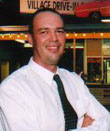|
|
This topic comprises 2 pages: 1 2
|
|
Author
|
Topic: Lamps for changeovers: Leave 'em on or off?
|
|
|
|
|
|
|
|
|
|
|
|
|
|
|
David Kilderry
Master Film Handler

Posts: 355
From: Melbourne Australia
Registered: Sep 1999
|
 posted 07-11-2000 04:20 AM
posted 07-11-2000 04:20 AM





David, You raise an interesting point. At our circuit - you know who we are - we have done a few experiments in the last few years. We have trialled in various multiplexes: Lamp on full all day. Lamp dropping to low current as you do. Lamp igniting at projector start and off at stop. We have also trialled Osram, Ushio and ORC lamps in that time. Our tests, although far from conclusive, showed none of the operating methods lead to substantially longer or shorter life. What we did find is that 15 minute after show blower (extraction cooling on timer at end of night)is required. Cinemeccanica Vic 5 console, Kinoton, Xebex and Strong LumeX lamphouses give the longest life (ahead of Strong X60C, X60D, Bauer U3, U4 and Christie). Ushio lamps provide the longest life. Rotation not required for most lamps. Where poor lamp life was experienced it was almost always one of 3 things: poor ventilation, bad rectifier, poor quality lamp brand. David
| IP: Logged
|
|
|
|
|
|
|
|
|
|
|
|
|
|
Scott Norwood
Film God

Posts: 8146
From: Boston, MA. USA (1774.21 miles northeast of Dallas)
Registered: Jun 99
|
 posted 07-12-2000 08:09 PM
posted 07-12-2000 08:09 PM





It's interesting that someone brought up the idea of running lamps at a lower "standby" current. With older Christie rectifiers, this isn't possible, since adjusting the rectifier requires killing the lamp. Oddly, though, the Eik EX-6100 16mm projectors that I've used are designed to do this--they take 1kw lamps that normally run at about 50 amps. After you strike the lamp, though, the current drops down to about 30 amps until you start the motor. These aren't my favorite projectors (great pix and sound, but they feel really cheap), but I always thought that this was kind of a neat feature, though I'd be interested to know if this actually does save the bulb life.
| IP: Logged
|
|
|
|
All times are Central (GMT -6:00)
|
This topic comprises 2 pages: 1 2
|
Powered by Infopop Corporation
UBB.classicTM
6.3.1.2
The Film-Tech Forums are designed for various members related to the cinema industry to express their opinions, viewpoints and testimonials on various products, services and events based upon speculation, personal knowledge and factual information through use, therefore all views represented here allow no liability upon the publishers of this web site and the owners of said views assume no liability for any ill will resulting from these postings. The posts made here are for educational as well as entertainment purposes and as such anyone viewing this portion of the website must accept these views as statements of the author of that opinion
and agrees to release the authors from any and all liability.
|

 Home
Home
 Products
Products
 Store
Store
 Forum
Forum
 Warehouse
Warehouse
 Contact Us
Contact Us




 Printer-friendly view of this topic
Printer-friendly view of this topic


















